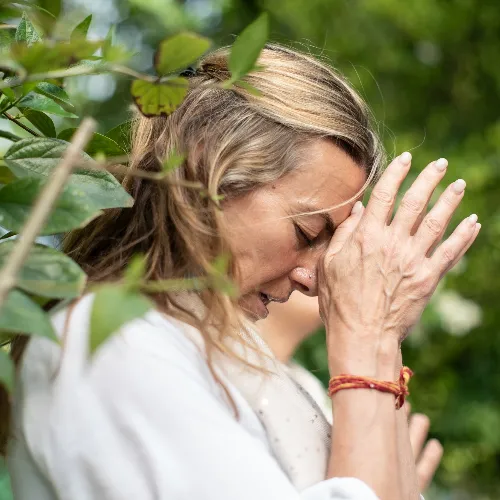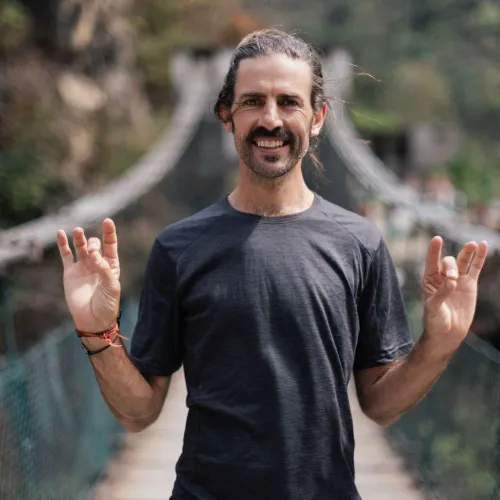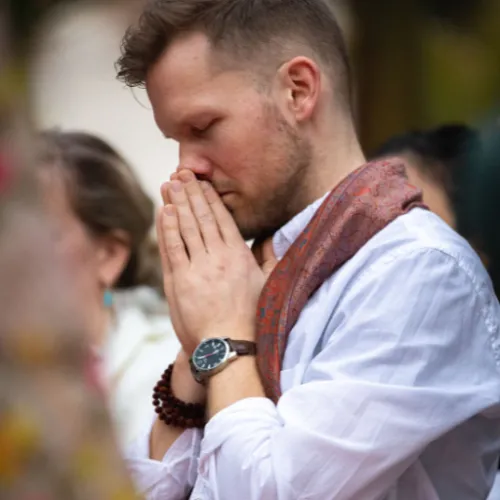


The yamas and niyamas are about the quality of states of consciousness. They are not setting out a moral code. They are not moral teachings. They are qualities that it would be wise to cultivate. They help you evolve and transcend.
The five Yamas are Ahimsa, Satya, Asteya, Bramacharya and Aparigraha. These are further explained below.
Ahimsa
Ahimsa is the transcendence of violence but this means more than what you would initially think. It is the state of non-violence. If you are not realizing your unity consciousness you are, on a certain level, violent because as long as you are bound by any identity, whether it’s nationality or religion or whatever it may be, you are going to be in conflict. Ahimsa is the state of unity consciousness. Only someone who is realizing their essential nature has access to non-violence as they are experiencing unity, love and when you are experiencing that love you will naturally radiate peace, non-violence. It is not by being non-violent that you move deeper into the state of yoga. It is by being in the state of yoga that you are able to achieve non-violence.
As you become really alert, really present, you begin to surrender to what Is and from that place arises appreciation for what Is. Then the correct responses, not reactions, will start to occur as you can only respond when you are not resisting what Is. Otherwise, you are reacting.
The state of ahimsa is not to be at peace but to Be peace. This is not fragile and it requires no particular setting as you are it; you are peace.
Satya
This yama is about speaking the truth. But the problem with that is that everybody thinks that they are speaking it, while their truth is simply a reflection of their state of consciousness.
The truth that is spoken of here belongs to no one and for it to be the truth it has to be unchanging. So it has to be beyond time, as anything that exists within time only has a relative value of truth. This truth speaks of the value of Self, the unchanging Sat; the essential nature of Self is Sat. So satya is the state of absoluteness, the unchanging consciousness. It is to know That by which everything else is known. As you begin to realize your own essential nature, you begin to know without knowing; you start to have access to the unified field, the mind of God.
Ultimately, the truth cannot be spoken or written as the moment it is, it becomes part of the relative reality and then people bring their own understanding to it. As your consciousness expands, you will have access to the field of silence where there is no word, no conditioning, no right or wrong, no judgment or fear. Then you can let the truth speak to you. It speaks in silence. As you have greater access to silence, you will have greater access to the truth.
When you are truthful to yourself, you are not lying to yourself anymore. You enter the state of truth. This is the most important practice.
Asteya
Asteya means non-stealing but it is much deeper than that. It is the realization that nothing belongs to you. No one actually owns anything. This idea of ‘me’ or ‘mine’ drops away. When you are in the state of yoga, you start to become non-attached, there is a natural letting go. Detachment starts to arise and you transcend the lower mind which is constantly dissatisfied.
As you move toward a greater state of unity, of yoga, you will add to any space you enter and fill it with your light as you will have access to the infinite field. This is the true value of asteya. Wherever you are in life, you are adding to the space.
Brahmacharya
Brahma is the cosmic Self and acharya means the one who is devoted to That, seeing as That, speaking as That. So, Brahmacharya is a state of consciousness where you start to experience things based on their fullest value. When you look at a rose, you experience its full value. When you look at another being, you experience their full value.
And a Brahmachari is someone who is devoted to the realization of Self, to the expansion of consciousness, to their love affair with the universe.
When you are in the state of Brahmacharya, everything is meditative. When you are eating, it is meditative. When you are walking, it is meditative. When you are laughing, it is meditative. All of it is as you realize that everything is an expression of infinite intelligence.
Aparigraha
Aparigraha is accessing the state of consciousness where needs drop away, being in a state of non-neediness. When you are in this state, your desires will be natural desires and you will be infinitely adaptable, having an infinite capacity to deal with whatever the universe is asking of you. This is mastery of life.
The five Niyamas are Saucha, Santosha, Tapah, Svadhyaya and Ishvara pranidhanani. These are further explained below.
Saucha
Saucha means purity in the sense of not putting toxins into your body, eating mindfully and not releasing toxins into nature. It also involves clearing out toxins and bio-memory from body and mind.
Santosha
Santosha is the recognition that grace is present in your life at all times. As you experience deep santosha, you will begin to resist nothing and then you will realize that what lies beneath the surface is the eternal flow of grace. This is the dropping of all resistance to what is, the dropping all stories and agendas, and allowing a deep state of appreciation of what is to arise. This then fills you with energy and vitality. Your mind becomes clearer and you can act in alignment with natural law, instead of against it. This is the state where there is no crisis. You can connect with the presence of grace no matter what is happening on the surface of your life and this fills you with ease.
Tapah
Tapah means fire. It is approaching life with passion, intensity, radical presence. Optimal energy will then become available to you. Show up to everything fully. Make everything you engage in a sacred act. This will give you a greater experience of unity consciousness and, then, this separation between the moment and you disappears, and you will have access to a level of intelligence that is very refined.
Tapah also refers to self-mastery, taking on a practice for a certain number of days to improve yourself in some way or make a commitment to yourself to let go of something that you know is not serving you.
Svadhyaya
Svadhyaya is the study of oneself, observing oneself. As you go deeper into the practice of yoga, this non-judgmental observation of yourself will naturally arise. This is a deep aspect of the state, practice and experience of yoga. It also means self-practice when no one is watching, when there is no external validation.
How are you when no one is watching?
Ishvara Pranidhanani
This is the absolute state of surrender, devotional surrender to the Divine that is always loving. Let go of the idea that the universe is hostile. All that is happening is love, so you always win when you surrender.
All the yamas and niyamas are qualities of being of someone who is in the state, practice and experience of yoga. And as we lean in that direction, we start to evolve and transcend.
Access deep yogic wisdom straight from the source on Sattva Connect. Study with Himalayan Master Anand Mehrotra.



























































































